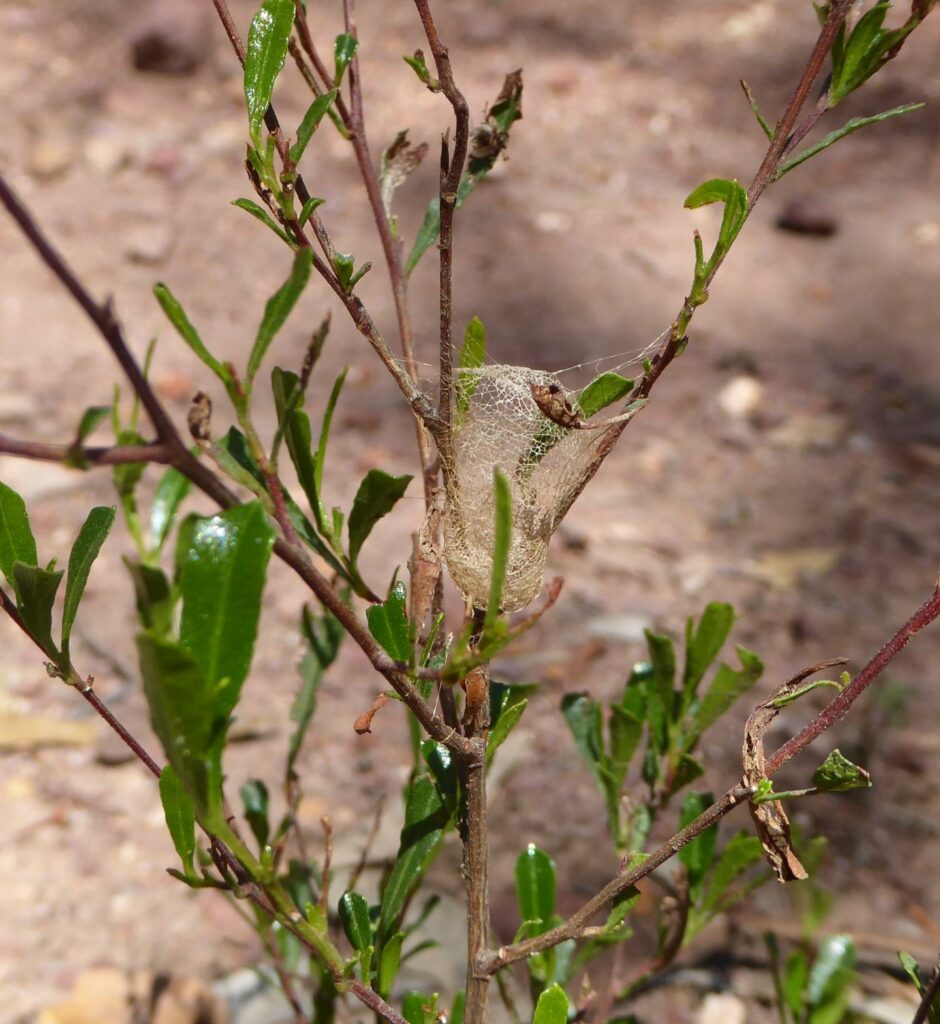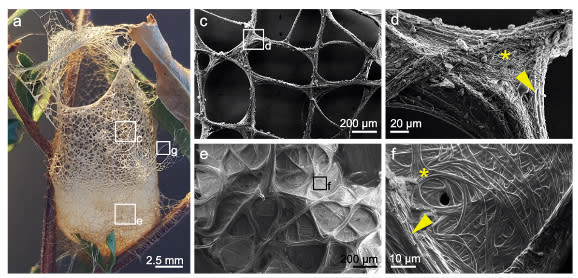When spiders typically weave their webs, they employ the help of the surrounding environment — whether it’s plants or the corners of our houses, spiders typically use something more rigid to support their webs. But not the basket-web spider.
As the name implies, the basket-web spider builds a different type of web: one that’s more similar to a container, suitable both for catching prey and for protecting its eggs.
The silk used to build the foraging web is similar to that used to make protective egg cases (and very different from the silk used to construct flexible foraging webs, like orb-webs), Professor Mark Elgar from the School of BioSciences at the University of Melbourne tells me in an email.
As far as we know, no other spider uses this type of web. Out of the many spiders that build webs, the basket weaver is the only one whose silk is so rigid that it retains structural integrity without help from the surroundings, which allows it to be used as a dangerous, foraging trap.
Until recently, not much was known about this unique web, but a new study by Elgar and colleagues at the University of Melbourne and the University of Bayreuth with the Australian Nuclear Science and Technology Organisation sheds new light on it. The researchers looked into the structure of the silk, and according to their work, the key is in the arrangement of the silk fiber.

The spider, also called Saccodomus formivorus is a member of the crab spider family, an endemic species that never really expanded past south-eastern Australia.
When entomologist William J Rainbow first described the basket-spider in 1900, he didn’t seem much interested in the nature of its silk and made no mention of it. Presumably, this was because he had only seen drawings of the web and imagined it to be different — otherwise, it’s hard to imagine an entomologist not getting excited by this type of web. Their very sturdy webs look a bit like lobster traps, which is why these spiders are also called “lobster pot spiders”.
Researchers now believe this feature first evolved as a way to protect their eggs from both the elements and any unwanted intruders.
“Spider eggs can be eaten by vertebrate predators, including birds and lizards, but are also parasitized,” Elgar explains in an email.
However, the spiders have also adapted this defensive technique into an effective offense, using the same type of web to capture unfortunate prey like ants. According to Elgar, the spider taps an unsuspecting ant worker, luring the ant to the web, where it is captured.
“Perhaps the basket-web is an extension of the protective egg case and represents a rare contemporary example of an evolutionary ancestral process,” Elgar notes.
Elgar and colleagues drove 2,000 kilometers to collect samples for analysis. They found that the baskets are approximately 11 millimeters in diameter and 14 millimeters deep, comprising of cross-linked threads of varying diameters. The baskets are firmly attached to branches and leaves by protruding threads from webs throughout the entire structure, Elgar explains.
The microstructure of the silk is also remarkably complex. Microfibers with a diameter of 2-4 micrometers are embedded in a polymer matrix, which in turn consists of even finer fibers, arranged in a longitudinal direction. The chemical composition of these smaller fibers is also different.
“Here, nature has created a complex structure that, at first glance, resembles industrially produced composites. However, further investigations into the Australian spider silk thread have shown that their chemically different components and their respective properties together result in the thread’s extreme elasticity and toughness, thus creating a high degree of robustness. With today’s composite materials, on the other hand, it is mainly the fibers embedded in the matrix that establish the particular properties required, such as high stability”, explains Prof. Dr. Thomas Scheibel, Chair of Biomaterials, who headed the research work at the University of Bayreuth.

When the researchers compared the basket spider silk to that of other spiders, they found substantial differences. These differences, explains Christian Haynl, doctoral student at the Biomaterials research group and first author of the new study, could tell us a lot about how spiders evolved.
“In comparative tests, we have found that the silk thread of this Australian crab spider has a much higher bending rigidity than the already well researched silk threads of the familiar orb-weaving spiders, such as the European garden spider. At the same time, the interaction of the two different types of fibres has broadened our scientific understanding of how spider silk works in general. This spider endemic to Australia offers us some surprising glimpses into the workshop of evolution,” says Haynl.
It wasn’t easy. To unravel the web’s secrets, the team used the Australian Synchrotron, a machine as big as a football field that accelerates electrons close to the speed of light. The electrons are then deflected through magnetic fields to reveal the molecular details of the analyzed structure, offering much more detail than conventional lab equipment — only with this, were they able to figure out the web’s composition.
In addition to solving one of nature’s mysteries, there’s also a very good chance there could be many practical applications to this study. As we’ve so often seen in recent years, we can draw valuable inspiration from nature.
“At this stage, we don’t know what practical outcomes there might be, but there are certainly more potentially practical applications now, than there were before we characterized the silk – this is why research like this is so important, we cannot be BioInspired without the biological knowledge,” Elgar concludes.
The study has been published in Nature.


